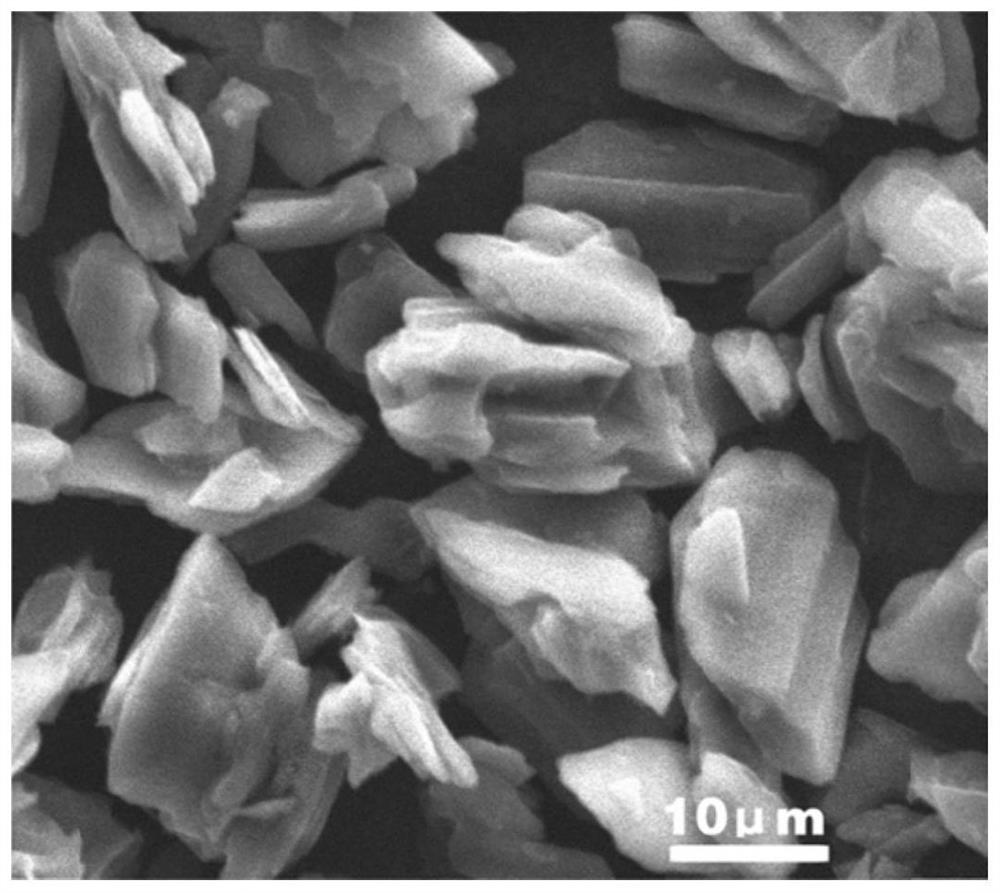Preparation method of high-capacity quick-charging graphite negative electrode material
A graphite negative electrode and high-capacity technology, which is applied in the preparation/purification of carbon, graphite, battery electrodes, etc., can solve the problems of not being able to balance capacity and fast charging performance
- Summary
- Abstract
- Description
- Claims
- Application Information
AI Technical Summary
Problems solved by technology
Method used
Image
Examples
Embodiment 1
[0032] (1) Raw material pulverization: pulverize the needle coke raw material, and shape it with a mechanical shaping machine until the D50 is 5-7 μm;
[0033] (2) Mixing: mix the pulverized raw material and petroleum pitch in a mixer in a mass ratio of 100:5;
[0034] (3) Granulation: Under the protection of an inert atmosphere, granulate in a reaction kettle at 550°C for 6 hours, and cool to room temperature to obtain a sample with a D50 of 10-15 μm;
[0035] (4) High-temperature graphitization: under the protection of an inert atmosphere, the granulated material is subjected to high-temperature graphitization at 2800 ° C for 72 hours, and cooled to room temperature;
[0036] (5) Classification: the material after graphitization is classified to obtain a sample particle size of 13-15 μm;
[0037] (6) Carbonization coating: Mix the graded samples and petroleum tar in a high-speed mixer at a mass ratio of 100:10, then carbonize at 1000°C for 12 hours under the protection of a...
Embodiment 2
[0040] (1) Raw material pulverization: pulverize the needle coke raw material, and shape it with a mechanical shaping machine until the D50 is 5-8 μm;
[0041] (2) Mixing: mix the pulverized raw material and coal tar pitch in a mixer in a mass ratio of 100:10;
[0042] (3) Granulation: Under the protection of an inert atmosphere, granulate in a reaction kettle at 600°C for 8 hours, and cool to room temperature to obtain a sample with a D50 of 12-16 μm;
[0043] (4) High-temperature graphitization: under the protection of an inert atmosphere, the granulated material was subjected to high-temperature graphitization at 2900°C for 48 hours, and cooled to room temperature;
[0044] (5) Classification: the material after graphitization is classified to obtain a sample particle size of 11-14 μm;
[0045] (6) Carbonization coating: Mix the classified samples and coal tar in a high-speed mixer at a mass ratio of 100:10, and then carbonize at 1100°C for 8 hours under the protection of ...
Embodiment 3
[0048] (1) Raw material pulverization: pulverize the needle coke raw material and shape it with a mechanical shaping machine until the D50 is 6-10 μm;
[0049] (2) Mixing: the pulverized raw material and the phenolic resin are mixed uniformly in a mixer at a mass ratio of 100:20;
[0050] (3) Granulation: Under the protection of an inert atmosphere, granulate in a reaction kettle at 650°C for 6 hours, and cool to room temperature to obtain a sample with a D50 of 13-16 μm;
[0051] (4) High-temperature graphitization: Under the protection of an inert atmosphere, the granulated material is subjected to high-temperature graphitization at 3000°C for 60 hours, and cooled to room temperature;
[0052] (5) Classification: the material after graphitization is classified to obtain a sample particle size of 13-16 μm;
[0053] (6) Carbonization coating: Mix the graded sample with the coating agent (the mass ratio of petroleum tar and graphene slurry is 3:1) in a high-speed mixer at a ma...
PUM
| Property | Measurement | Unit |
|---|---|---|
| specific surface area | aaaaa | aaaaa |
| particle diameter | aaaaa | aaaaa |
| particle diameter | aaaaa | aaaaa |
Abstract
Description
Claims
Application Information
 Login to View More
Login to View More - R&D
- Intellectual Property
- Life Sciences
- Materials
- Tech Scout
- Unparalleled Data Quality
- Higher Quality Content
- 60% Fewer Hallucinations
Browse by: Latest US Patents, China's latest patents, Technical Efficacy Thesaurus, Application Domain, Technology Topic, Popular Technical Reports.
© 2025 PatSnap. All rights reserved.Legal|Privacy policy|Modern Slavery Act Transparency Statement|Sitemap|About US| Contact US: help@patsnap.com

